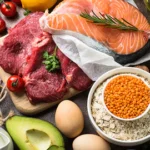A questions arise in a newcomer or skinny person’s thoughts “how can i build muscle mass?” So, building muscle is a journey that requires discipline, consistency, and a thorough understanding of exercises, nutrition, and strength. This guide will give you the strategies and insights “how can i build muscle mass and gain more strength?“. We will cover important principles, best exercises, nutrition, and basic recovery tips to ensure continuous improvement.
Understanding Muscle Growth: Hypertrophy and Strength
How can i build muscle mass? it’s crucial to understand the process of muscle hypertrophy. When you engage in resistance training, your muscle fibers undergo microscopic damage. Your body then repairs the fibers to make them thicker and stronger. This process requires both adequate resistance training and recovery, supported by the right nutrition.
Key elements that promote muscle hypertrophy include:
- Progressive Overload: Gradually increasing the stress placed on muscles by lifting heavier weights or performing more repetitions.
- Mechanical Tension: The amount of force applied to muscles during resistance exercises.
- Muscle Damage: Microtears in the muscle fibers that trigger the repair and growth process.
- Metabolic Stress: The buildup of byproducts in the muscle from intense exercise that contributes to muscle growth.
- Volume and Frequency: The total amount of work done, including sets, reps, and training days.
- Recovery: Muscle growth occurs during rest, so proper recovery is essential.
Best Exercises for Muscle Growth
The following best exercises for muscle growth target key muscle groups and are fundamental to improving strength and muscle size. Focus on compound movements that involve multiple muscles, and include isolation exercises to target specific areas.
1. SQUATS

Squats are essential for lower body development as it one of the best compound exercise, working the quadriceps, hamstrings, glutes, and core. They also promote overall strength and hormonal responses that enhance muscle growth.
FORM TIP
- Keep your feet shoulder-width apart.
- Keep your back straight, bend your knees and lower your body.
- Push your heels back to the starting position.
2. DEADLIFTS
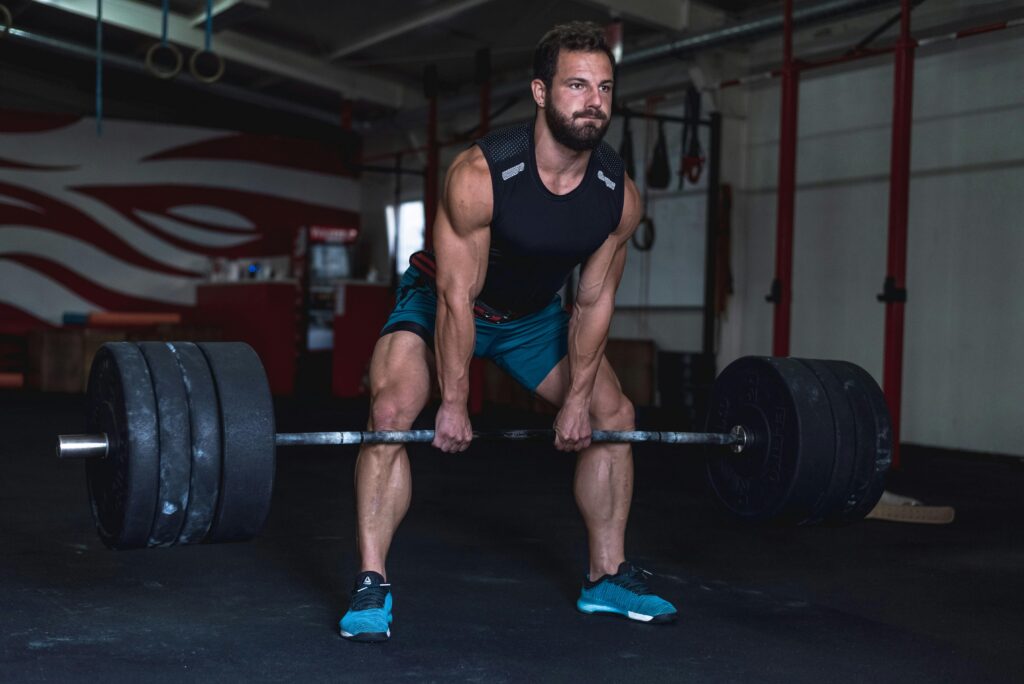
Deadlift is the best compound exercise known for its overall muscle targets. It targets the posterior chain, including the back, glutes, hamstrings, and core. They are excellent for overall strength and mass development.
FORM TIP
- Hold the barbell just behind your knees and stand with your feet hip-width apart.
- Touch your heels and keep your back straight as you lift the barbell.
- Take control and slowly lower the weight to its starting point.
3. BENCH PRESS

The bench press is the compound exercise for building chest, shoulders, and triceps. It allows you to lift heavier weights, contributing to muscle hypertrophy.
FORM TIP
- Lie flat on a bench with your feet firmly on the floor.
- Hold the barbell with your arms slightly wider than your shoulders.
- Lower the barbell down to your chest, then press it back up to the starting position.
READ MORE: Go through the blog Best Chest Workout at the Gym and claim your dream chest physique.
4. PULL-UPS
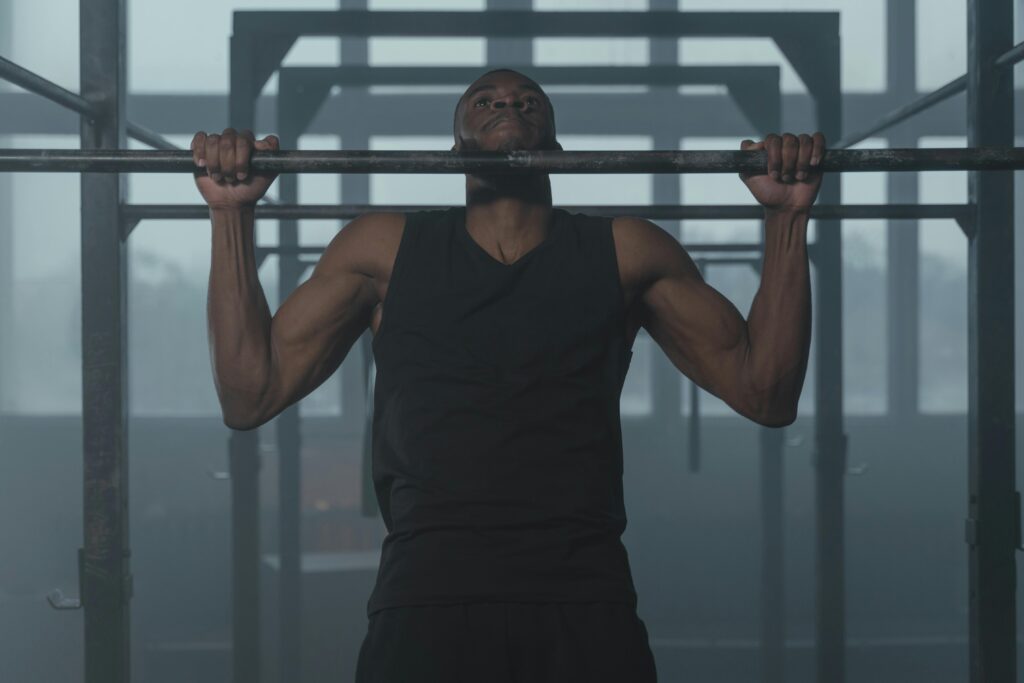
Pull-ups are one of the best exercises for building upper back and biceps. They also engage the core muscles, making them a best compound exercise.
FORM TIP
- Grip the bar with your palms slightly wider than your shoulders.
- Pull yourself until your chin clears the bar and hold for 1-2 seconds.
- Lower yourself slowly to allow the muscles to engage properly.
5. OVERHEAD PRESS

The overhead press builds strong shoulders, triceps, and engages the core. It promotes stability and upper body strength, making it one of compound exercise.
FORM TIP
- Stand with your feet slightly shoulder-width apart and hold the barbell at shoulder height.
- Tighten your core and press the weight up overhead.
- Lower the barbell back to the starting position.
READ MORE: If you want to build a strong rounded shoulder, check the blog Best Shoulder Workout at the Gym you will get through.
6. BICEP CURLS
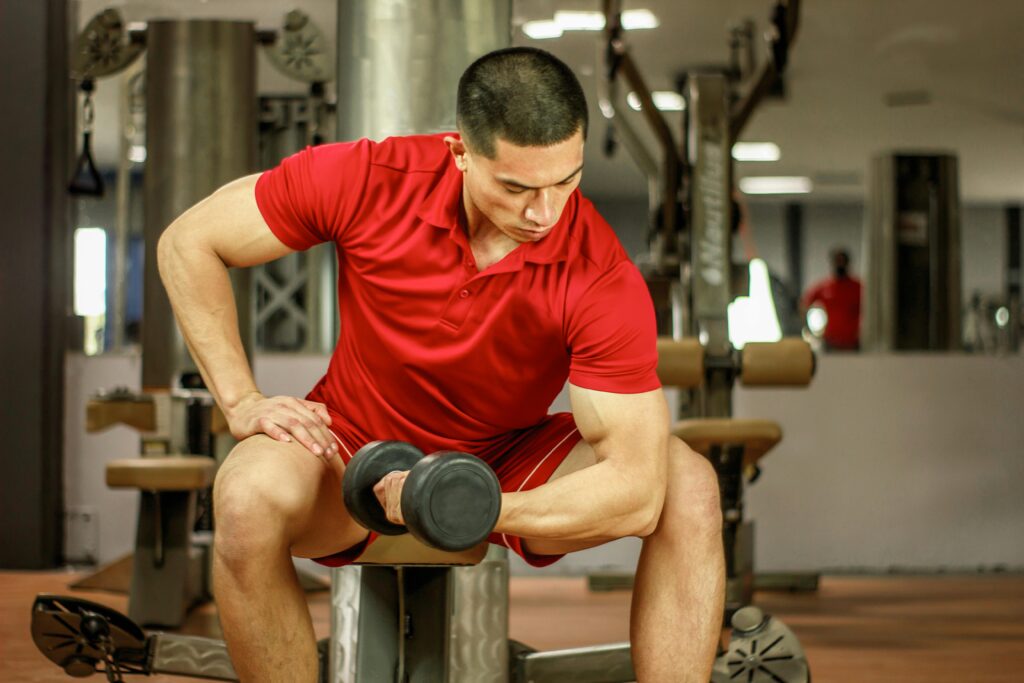
A bicep curl is a weight and isolated exercise that strengthens the biceps, the muscles in the front of the upper arm.
FORM TIP
- Stand straight or sit on a bench and hold a pair of dumbbells on both hands with palms facing up.
- Slowly bend your elbows and pull the weight in a curl position.
- Keep your elbow close to your body.
7. Tricep EXTENSION

A tricep extension is an isolated exercise that strengthens and tones the triceps muscle in the back of your upper arm. It involves bending the elbow and extending the hand behind you while keeping the shoulder still.
FORM TIP
- Grab a dumbbell or a cable with both hands behind your neck, with your elbow bent to 90 degrees.
- Slowly move the weight upward, along with straightening the elbow.
- Lower the weight to the starting position and repeat the same process.
8. LATERAL RAISES

A lateral raises, also known as a side lateral raises, is an isolated exercise that involves lifting weights away from the body to strengthen the shoulder muscles (specifically the lateral deltoids).
FORM TIP
- Hold a pair of dumbbells with both hands and stand in an upright position.
- Raise the dumbbells upward with a slightly bent in elbow, making a T-shape equal to the shoulder height.
- Slowly lower the dumbbells to the starting position.
READ MORE: If you want to build a strong rounded shoulder, check the blog Best Shoulder Workout at the Gym you will get through.
9. LEG CURLS
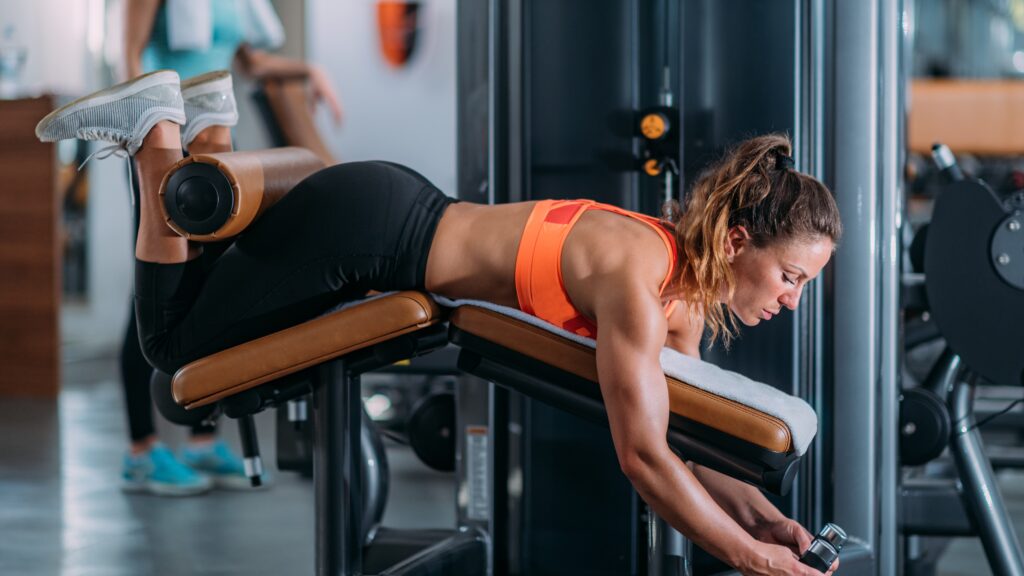
A leg curl, also known as a hamstring curl, is an isolated exercise that strengthens the hamstring muscles in the back of your legs. It’s an isolation exercise, which means it targets specific muscle groups and can be done in a variety of positions.
FORM TIP
- Lie face down on the leg curls machine and hold the support handle, extend your legs and fix on the roller pad just above the heels.
- Pull the roller pad with your ankle as close as possible to your buttocks and hold for a few seconds.
- Slowly lower the pad to the starting position in a controlled form.
Training Volume and Frequency
Training volume refers to the total amount of work or activity performed during a training session, week, or program. It’s a key variable in training programs, along with proper intensity. Exercise frequency refers to the number of times you exercise, usually in a week. This is an important part of the FITT principle, which is a guideline for creating or modifying exercise programs.
For optimal muscle growth:
1. Train each muscle group 2-3 times per week to maximize protein synthesis.
2. Do 3-6 sets per exercise, with 8-12 reps per set for hypertrophy.
3. Rest 60-90 seconds between sets to maintain tension and promote muscle growth.
STRUCTURE WORKOUT PLAN
Once you get through the compound exercise and isolated exercise their form, it is time to structure your workout plan for a week which will give a proper direction on which muscle you should focus. The workout plan given below will help you to get through your solution where you can change the exercises as per your choice:
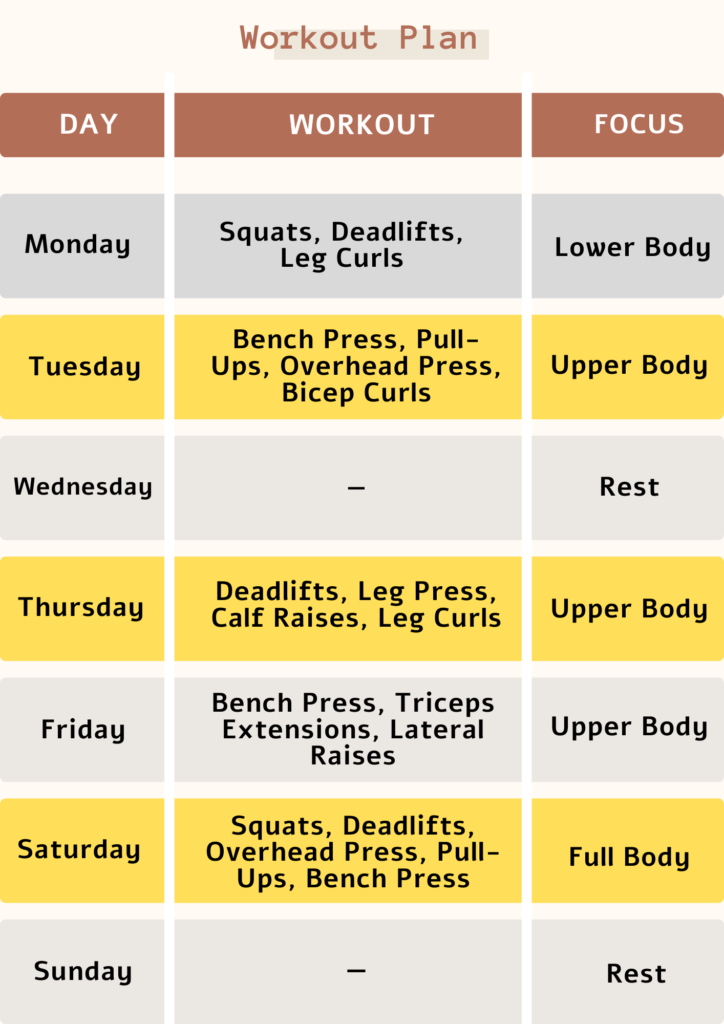
Muscle-Building Foods into Your Diet
Proper muscle growth requires not only the right foods, but the timing, distribution, and balance of your diet. Below we will discuss the main ways to incorporate these muscle-building foods into your diet plan effectively:
1. Prioritize Protein with Every Meal
Consistent high-quality protein intake throughout the day is essential for muscle growth. Aiming for at least 20-30 grams of protein per serving is ideal to provide a good balance of nitrogen, which is essential for muscle building.
Example Meal Plan:
- Breakfast: Scrambled eggs with spinach, rice toast and Greek yogurt.
- Lunch: Roasted chicken breast with quinoa and slices of broccoli.
- Snacks: almonds and bananas.
- Dinner: Salmon with sweet potatoes and Brussels sprouts.
- Post-workout shake: Whey protein shake with chia seeds and almond milk.
2. Time Your Carb Intake for Performance
Carbohydrates are needed to maximize intense exercise and replenish glycogen stores. The best time to eat more carbs is around your workouts — before a workout, and after for recovery.
Pre-Workout Carbs:
- Oats or bananas wrapped in protein (such as eggs or Greek yogurt) are a good pre-workout meal for lasting energy.
Post-Workout Carbs:
- Brown Rice or sweet potatoes can be wrapped in a lean protein (such as chicken breast or chicken breast) to replenish glycogen and promote muscle recovery.
3. Incorporate Healthy Fats for Hormonal Balance
Healthy fats like those found in almonds, salmon, and chia seeds support testosterone production and reduce inflammation, which can help muscle growth and recovery.
Fat sources included:
- Include avocados in your diet for healthy monounsaturated fats.
- Incorporate olive oil into your cooking.
- Eat sweet pumpkin seeds for a combination of more nutrients, fat and protein.
4. Utilize Plant-Based Protein for Variety
Adding plant-based proteins like tofu, legumes, and quinoa can diversify your nutritional intake and support your muscle-building efforts. These plant-based foods are rich in essential amino acids and fiber, making them valuable in a balanced diet.
Plant-Based High-Protein Meals:
- Add vegetable and quinoa mixture to tofu.
- Lentil soup with a whole grain roll.
- Edamame and buckwheat salad for a quick lunch option.
5. Stay Hydrated for Optimal Performance
Hydration plays an important role in muscle function, endurance, and recovery. Drinking plenty of water provides your muscles with essential nutrients while also helping to detoxify them. Include water-rich foods like oranges, cucumbers and oranges in your water intake.
6. Don’t Forget Micronutrients
Vitamins and minerals play an important role in muscle function and repair. For example, spinach and pumpkin seeds provide the magnesium needed for muscle contraction. Beetroot improves nitric oxide levels and increases blood flow to muscles during exercise.
Micronutrient-Rich Foods to Focus On:
- Spinach for iron and nitrate.
- Brussels sprouts provide vitamin C and fiber.
- Almonds for vitamin E, which helps repair damaged tissue.
7. Use Supplements Wisely
While whole foods should make up the bulk of your muscle-building diet, supplements like whey protein and creatine can be valuable tool to slim down and boost your performance Whey protein is ideal post-workout because of its rapid absorption, while creatine boosts strength and power during training.
Recommended Supplements:
- Whey protein recovery after exercise.
- Creatine increases strength and muscle mass over time.
- BCAAs (Branched-Chain Amino Acids) during exercise to prevent muscle damage.
Example Meal Timing for Maximum Muscle Gain
Timing meals and snacks is important for proper muscle protein synthesis and energy. Here’s a sample mealtime day to help you organize your nutrition around your workout.

Recovery and Sleep
Muscle growth occurs at rest, not exercise. Without proper recovery, your muscles will not repair or grow properly. Make sure that:
- Get 7-9 hours of sleep per night: Sleep is when most muscles repair. Growth hormone is also released during deep sleep, which is essential for muscle growth.
- Include rest days: Give your muscles time to recover by scheduling rest days or light recovery periods to avoid overtraining.
CONCLUSION
Building muscle is a science that requires a commitment to proper training, nutrition and recovery. You can achieve the muscle growth you want by following the principles of progressive overload, choosing the right exercises, eating a balanced diet rich in protein and other macronutrients, and giving your body time for recovery Keep using these techniques, and you will see that a noticeable improvement in your muscle weight and overall physique.
Share this post: on Twitter on Facebook


